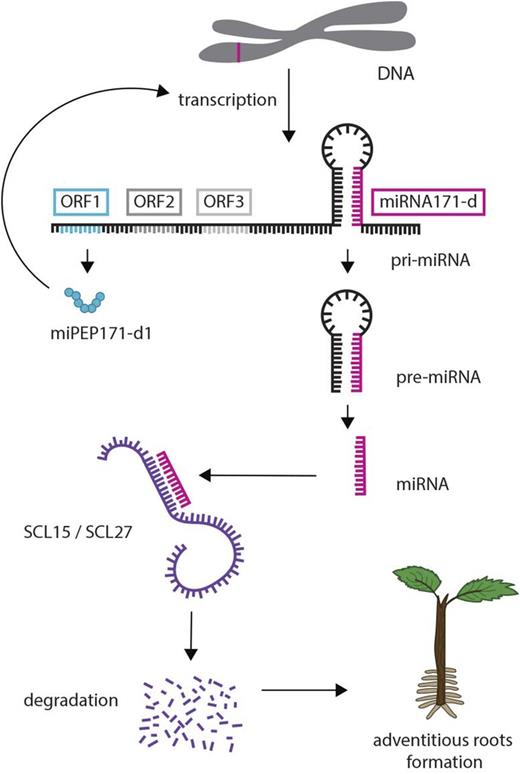-
PDF
- Split View
-
Views
-
Cite
Cite
Magdalena Julkowska, Small But Powerful: MicroRNA-Derived Peptides Promote Grape Adventitious Root Formation, Plant Physiology, Volume 183, Issue 2, June 2020, Pages 429–430, https://doi.org/10.1104/pp.20.00515
Close - Share Icon Share
Although plant genomes typically contain hundreds of microRNA (miRNA)-encoding genes, we know little about how miRNA expression is regulated (Wang et al., 2019). The expression of Arabidopsis miRNA171, which targets SCARECROW-like transcription factors involved in lateral root formation, was previously described to be controlled by small peptides derived from small open reading frames (ORFs) on the same primary transcript as miRNA171 itself (Fig. 1; Lauressergues et al., 2015). This discovery of miRNA-derived peptides (miPEPs) opened the door for new technologies controlling gene expression without the need for genetic modification.

Schematic overview of vvi-miRNA171d processing and the effect of vvi-miPEP171d1 on adventitious root formation. The primary transcript of miRNA171 (pri-miRNA) is transcribed by RNA polymerase II and processed into pre-miRNA in the nucleus. The pre-miRNA is subsequently cleaved into mature miRNA, which binds to target mRNA, resulting in transcriptional repression. The small ORFs preceding the miRNA on the pri-miRNA are also transcribed and translated into small peptides. The peptide from the first ORF, containing seven amino acids, results in higher expression of pri-miRNA171d, which in turn results in the transcriptional repression of the SCARECROW-like transcription factors SCL15 and SCL27, leading to enhanced adventitious root formation.
Adventitious root formation is an important agronomic trait in grapevine (Vitis vinifera), as it allows successful propagation by cuttings. In this issue of Plant Physiology, Chen et al. (2020) examined if the adventitious root formation in grapevine could be promoted by targeting specific miRNAs expressed during adventitious root formation. Chen et al. (2020) identified 10 grape homologs of miRNA171 and focused on miR171d, the expression of which coincides with the timing of adventitious root formation across multiple grapevine varieties. The team examined a 500-bp sequence upstream of premiR171d and identified three small ORFs encoding peptides within this region (Chen et al., 2020). Transient overexpression of individual ORFs indicated that only the first ORF, vvi-miPEP171d1, encoding a peptide of seven amino acids, increased miR171d expression, while application of it reduced expression of the SCARECROW-like transcription factors VvSCL15 and VvSCL27. More importantly, treatment with synthetic vvi-miPEP171d1 increased the number of adventitious roots (Fig. 1; Chen et al., 2020), indicating that the exogenous peptide treatment can be used for grapevine cutting propagation. Intriguingly, while overexpression of grapevine miRNA171d enhanced adventitious root formation in Arabidopsis (Arabidopsis thaliana), the effect of the small peptide itself was absent, suggesting species-specific conservation of miPEP function.
The work by Chen et al. (2020) demonstrates that miPEPs can target the desired phenotype with surgical precision. As miPEPs act only in the cells expressing their encoding miRNAs, their application results in a more contextual phenotype (Couzigou et al., 2015), unlike the ectopic overexpression of miRNAs, which impacts multiple agronomically relevant traits (Huang et al., 2017). It is unknown if miPEPs can enhance miRNA expression in the presence of so-called molecular sponges, long noncoding RNAs derived from transposable elements, which reduce miRNA171 in rice (Oryza sativa) during lateral root formation (Cho and Paszkowski, 2017). Although the range of agricultural applications for miPEPs remains to be explored, the results presented by Chen et al. (2020) encourage future efforts to manipulate the regulation of gene expression using miPEPs while circumventing the need for genetic modification.
LITERATURE CITED
Author notes
Senior author.



